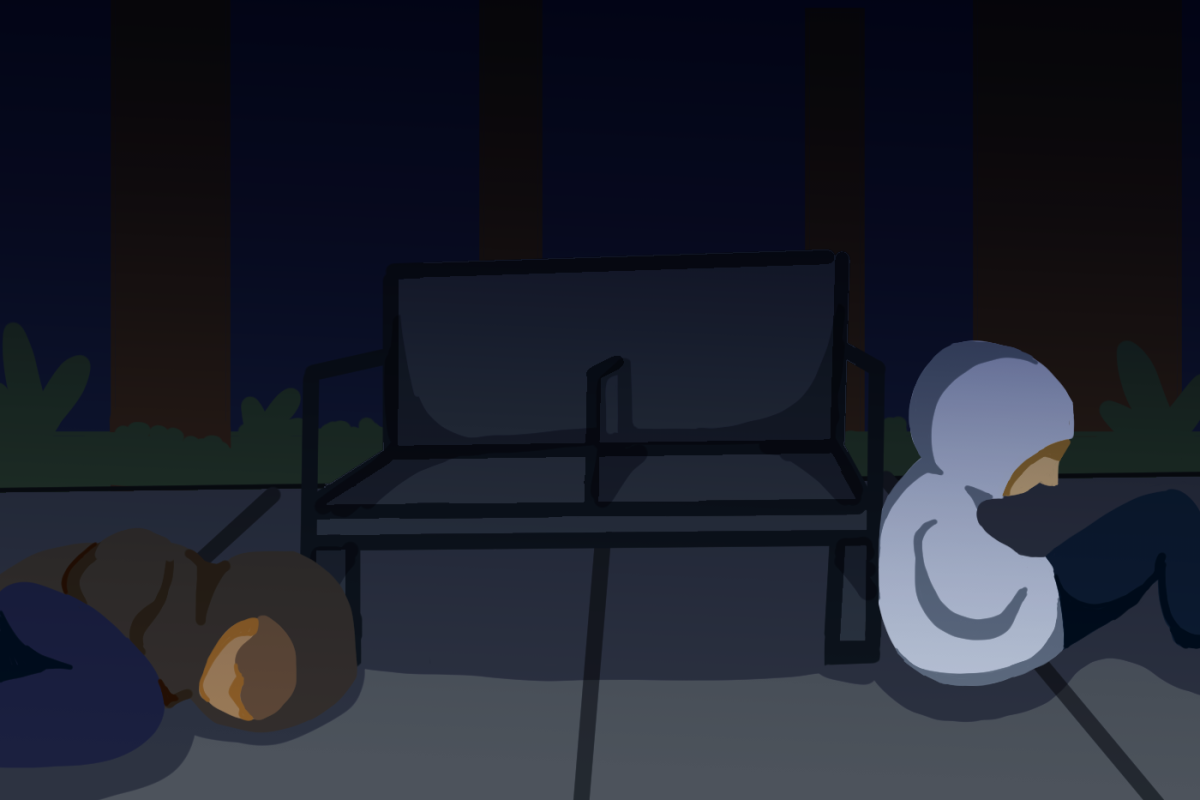As more and more of our people are being forced to survive on the streets, America is fighting back – just not in the way one would hope.
The U.S. Housing and Urban Development’s information site, the HUD Exchange, reports in the Annual Homelessness Assessment that on any given night in 2022, approximately 582,500 people were struggling with homelessness. Of those 582,500 people, only 60% were able to find a shelter or housing program while the other 40% were stuck living on the streets.
But homeless people cannot live on the streets, either. Cities like San Francisco, Los Angeles, New York, and even Wichita, are purposefully making public sidewalks and streets inhospitable by implementing hostile architecture. From an urban design perspective, hostile architecture is meant to deter activity that could harm the people walking by or the surrounding businesses. Unfortunately, this architecture is also used to discriminate against homeless people while passing as something helpful to the rest of the community–the people America feels like helping.
One example of hostile architecture, the Camden bench, makes anything but sitting impossible. As a massive slab of concrete, it purposefully has no crevices for people of the city to stash drugs or litter and is slanted to “discourage skating.” Conveniently, it is also impossible to sleep on.
Some of these anti-homeless designs are more obvious, such as street spikes, while objects like planters can be disguised as adding a nice touch of green to a gray city. In reality, sometimes the purpose of planters is to split up the sidewalk into a safe, walkable area, and push homeless people closer to the cars in the street. Even more horrible and inhumane designs such as fences around vents are there to restrict people from keeping warm.
This sends the message that homeless people doing their best to survive with very little are creating a bad image for the city. We could be doing much more to help these people rather than trying an “out of sight, out of mind” approach to not make it our problem. Regardless of one’s socioeconomic status, everyone deserves a roof over their head.
Many of us do not acknowledge the luxury of sleeping in our own bed in a private home. Imagine how it would feel to sleep on the ground in public where anyone could stare at you. That is 582,500 people’s only option–and we’re taking that away, too.
Hypothetically, if a person who is well-dressed falls asleep on a park bench, how do you think the public would react? They would either be left alone or maybe someone would stop to make sure they’re okay. Homeless people, however, are not regarded with the same respect and human decency.
The existence of anti-homeless architecture reflects how America views homeless people in a negative lens and exposes how homelessness continues to be a large issue that is brushed to the side.
It is obvious; we have an implicit bias towards homeless people. If we create the narrative in our minds that these people are scary, unapproachable, drug addicts, erratic, dirty, or criminals, or that maybe if they just got a job and contributed to society like the rest of us they wouldn’t be in this situation, we make it easy on ourselves to retreat to our comfortable lives and not help. With this mindset, why would anyone in their right mind want to help someone like that?
We devalue homeless people to try to make this huge problem smaller and force it out of view. In 2015, San Francisco introduced hydrophobic, UV-treated paint. It has been called “pee-proof” paint, as the goal is to cut down on public urination by making it so that your urine bounces back onto you.
It is understandable to discourage public urination for hygienic reasons, but it is not the fault of a homeless person. Homeless people would like a clean place to live just like the rest of us, but what other choice have we given them? Oftentimes, public bathrooms are closed at certain hours specifically so homeless people cannot take shelter there nor relieve themselves. Other restrooms are reserved only for customers.
We’re causing the problem, and then blaming the victims for the ways they have to fight to survive it. Hostile architecture does not address the crisis of homelessness, it only further builds a negative reputation for homeless people as they find worse ways to cope. These people have nowhere else to live. We either need to give them a better place to live or at the very least, let them live on the streets in peace. If you fell on the hardest of times, wouldn’t you want the same?






Nina Shadden • Sep 4, 2023 at 5:00 am
I absoultly love this post. I myself am a single mother of 2 kids n 2 gteat danes. We became homeless due to the fact of our safety being jopordized. So i had to make a hard decision. And leaving where we had all called home for over a few years was necessary. I tried so hard to get a homeless prevention grant. But then i couldnt find a landlord or company that was willing to work with it. Or the 1s that were willing to acknowledge the grant. Werent willing to accept animals. Most people would have gotten rid of the dogs. However for my family, i felt that was going to be more trauma to endure. So i decided that no matter what im going to keep my heart beats together. And its been 3 long n exhausting years n i still am doing my very best but still having trouble secureing permanent houseing. But we stay positive n no 1 chooses to be homeless, sometimes it just happens. N its so hard to not feel like a failure as a parent to be able to do whats so important to have from the foundation up.
Anonymous • Sep 3, 2023 at 9:54 am
How wicked is humanity. Humans are the only devils on earth. Not to worry, none of these devils shall escape bitter perpetual sorrow and suffering. All that they do and all that they are shall fall back on them. Until they wake up these devils call human shall suffer. From life to life. These animal eating devils, believers in their mind created God shall not escape their evil ways, Not even narrowly.
Chris • Sep 3, 2023 at 6:34 pm
Well put.thanks
Barbara Maisch • Sep 3, 2023 at 8:15 am
The city can build dog parks, golf courses and pay for art work throughout the city, but there is no money to build housing which could be used by homeless people. By housing I am talking about something along the line of motel-sized rooms with a bathroom. Even buying an already existing hotel or motel would solve a lot of the problems of the homeless. These rooms would be available as temporary housing while transitioning people into jobs and regular housing as they are lifted up and out of homelessness. Unlike money spent on other things, these people would be an investment in our community.